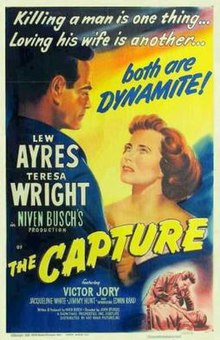The Capture (film)
 From Wikipedia - Reading time: 7 min
From Wikipedia - Reading time: 7 min
| The Capture | |
|---|---|
 Theatrical release poster | |
| Directed by | John Sturges |
| Written by | Niven Busch |
| Produced by | Niven Busch |
| Starring | Lew Ayres Teresa Wright |
| Cinematography | Edward Cronjager |
| Edited by | George Amy |
| Music by | Daniele Amfitheatrof |
| Color process | Black and white |
Production company | Niven Busch Productions |
| Distributed by | RKO Radio Pictures |
Release date |
|
Running time | 90 minutes |
| Country | United States |
| Language | English |


The Capture is a 1950 American Western film directed by John Sturges and starring Lew Ayres and Teresa Wright.[2]
The story, told in flashback deals with an ex-oil worker driven by guilt at causing the death of an innocent man to find out the truth about a robbery.
Plot
[edit]Lin Vanner is the manager of an oil company. The payroll has been stolen in a holdup. His fiancée urges him to pursue the suspect in hope that he will gain recognition. Deducing the road the robber may have taken over the border with Mexico, he sets out to intercept him. He shoots a man who shouts back at him and does not raise his hands when challenged by Lin.
Too late Lin learns that the man could not raise one arm because it was injured and this was the reason for his shouting rather than complying with the demand he raise his hands; he was not guilty of the robbery. Troubled by his action and abandoned by his fiancée, Lin takes it on himself to tell the dead man's wife, Ellen, but is mistaken for an applicant for a helper to keep the dead man's farm going until his widow's son is old enough to take over.
Lin believes that this opportunity has been given to him to make amends for his mistake.
With Father Gomez at his side, the story that he is being pursued by the police for another killing is told in a flashback.
Cast
[edit]- Lew Ayres as Lin Vanner
- Teresa Wright as Ellen
- Victor Jory as Father Gomez
- Jacqueline White as Luana Ware
- Jimmy Hunt as Ellen's son
- Barry Kelley as Earl C. Mahoney
- Duncan Renaldo as Carlos
- William Bakewell as Tolin
- Milton Parsons as Thin Man
- Frank Matts as Juan
- Felipe Turich as Valdez
- Edwin Rand as Sam Tevlin
Reception
[edit]Critical response
[edit]When the film was released, the staff at Variety gave the film a generally favorable review, writing "The Capture is an offbeat drama, with psychological overtones, that plays off against the raw and rugged background of Mexican locales. Picture kicks off with a wallop ... Ayres and Teresa Wright are very capable in the lead characters, adding to the general realism given the story because of the locales used. One of the interesting touches to the film is the incidental native music hauntingly spotted with the appearance of a blind guitar player."[3]
See also
[edit]References
[edit]Notes
[edit]- ^ "The Capture: Detail View". American Film Institute. Retrieved May 18, 2014.
- ^ The Capture at the AFI Catalog of Feature Films
- ^ Variety. Staff film review, 1950. Accessed: July 18. 2013.
Bibliography
[edit]- American Film Institute. AFI Catalog of Motion Pictures Produced in the United States, Volume 1. The Capture, p. 378. University of California Press, 1971. ISBN 0-520-21521-4.
- Howard Reid, John Howard. Movie Westerns:Hollywood Films the Wild, Wild West. The Capture, p. 45. Lulu.com, 2005. ISBN 1-4116-6610-0.
- Selby, Spencer. Dark City: The Film Noir. Jefferson, North Carolina: McFarland Publishing, 1984. ISBN 0-89950-103-6.
External links
[edit]- The Capture at the AFI Catalog of Feature Films
- The Capture at IMDb
- The Capture at AllMovie
- The Capture at the TCM Movie Database
- The Capture at Rotten Tomatoes
- The Capture is available for free viewing and download at the Internet Archive
- The Capture complete film on YouTube (film in public domain)
 KSF
KSF